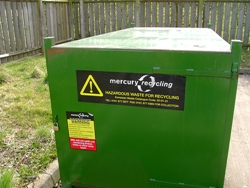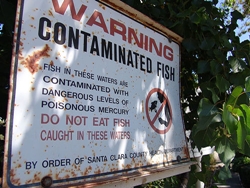Do the right thing – recycle, don’t throw out, your fluorescents
Recycling fluorescent light bulbs is a basic environmental responsibility we should all take seriously. Fluorescent lights contain small amounts of mercury (about 1/100th of what’s in a mercury thermometer). Mercury is highly toxic. Throwing fluorescent lights in your trash means that mercury eventually leaches out of the landfill into the ground or the water supply. And in many areas, doing so is illegal.
Recycling fluorescent tubes and light bulbs is easy. Most municipalities have hazardous waste depots, or (for rural municipalities) provide a fluorescent bulb recycling bin at the local dump.
Recycling fluorescent light bulbs is important for your own health and that of the planet. Fluorescent bulbs contain a trace amount of mercury (about 1/100th of what’s in a mercury thermometer) so proper fluorescent disposal is very important.

Fluorescent lights contain mercury – please recycle!
Remember, it’s better to use fluorescent than incandescent lights, even though fluorescent lights contain mercury. Coal-fired power plants emit tons of mercury every year. Some people argue that the fluorescent light over its lifetime will save more in mercury emissions than the mercury it contains, though this isn’t really true even if your electricity comes 100% from coal – which is increasingly not the case these days.
Still, replacing an incandescent with a compact fluorescent can save up to a ton of CO2 emissions, and if you recycle the fluorescent bulb then no mercury is released by the bulb itself. You come out ahead on both counts.
It may be legal in some jurisdictions to simply throw your used energy efficient fluorescent bulbs and tubes in the trash. Some websites recommend consulting with your local environmental or waste management department to find out what is legal. My advice is to not worry about what is legal and do instead what is right – recycling fluorescent light bulbs so that you prevent any mercury from escaping into the environment.
People throw out around 600 million fluorescent lights per year, which works out to 30,000 pounds of mercury. Just a half teaspoon of mercury can contaminate a stream or small lake, making the fish unsafe for human consumption. Recycling fluorescent light bulbs is a small effort on your part and makes a big difference to the health of our environment.

What happens when you don’t recycle
Of course, if you don’t buy fluorescent light bulbs to begin with, you won’t have this disposal problem. LED lights are now almost as cheap as fluorescent lights, last about ten times longer, and use about half the electricity for the same amount of light. They also provide a lighting experience closer to the warm incandescent light many of us grew up with. LED lights are up to ten times more efficient than incandescent or halogen bulbs and don’t contain any toxic mercury.
Start by contacting your local waste management department. (Do a search on “waste management” and include your state/province and town/city/county name). Phone them, and ask about locations for recycling fluorescent light bulbs. Don’t let them tell you it’s safe to throw them away! You might even add ‘fluorescent’ to your search. For example, I tried this search on Google for my own city:
And immediately found a page from the City of Toronto Solid Waste Management department that includes this text:
The City of Toronto directs residents to safely dispose of fluorescent tubes and CFLs using one of the following options:
- Drop off fluorescent tubes and CFLs at one of the City’s six Solid Waste drop-off depots…
- Make an appointment with Toronto’s “Toxics Taxi” service … to pick up your HHW.
- Bring fluorescent tubes and CFLs to your local Community Environment Day event.
If your local waste management department can’t tell you where to recycle fluorescent bulbs, try your local building center or lighting store. Many of the big-box building centers have CFL recycling boxes. If they don’t provide fluorescent recycling boxes, talk to the store manager and tell them they should! My local Home Depot has had a CFL recycling bin at the store entrance for several years now.
If you’re unable to find an easy way to recycle your fluorescent light bulbs, or if you want to do some good in the world, start an energy efficient fluorescent recycling program of your own. A friend of mine started a program for recycling fluorescent light bulbs and dead batteries at our local public school, so anyone in the community has an easy way of safely recycling fluorescent light bulbs whenever they need to. The bulbs at the school are regularly removed and sent to a toxic waste depot where they are safely recycled. That encourages people to recycle them instead of throwing them out.

Leave a Reply
Want to join the discussion?Feel free to contribute!